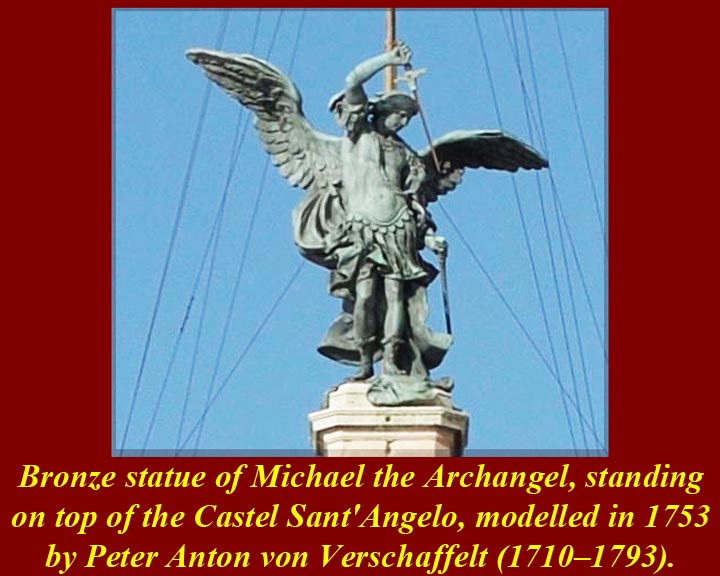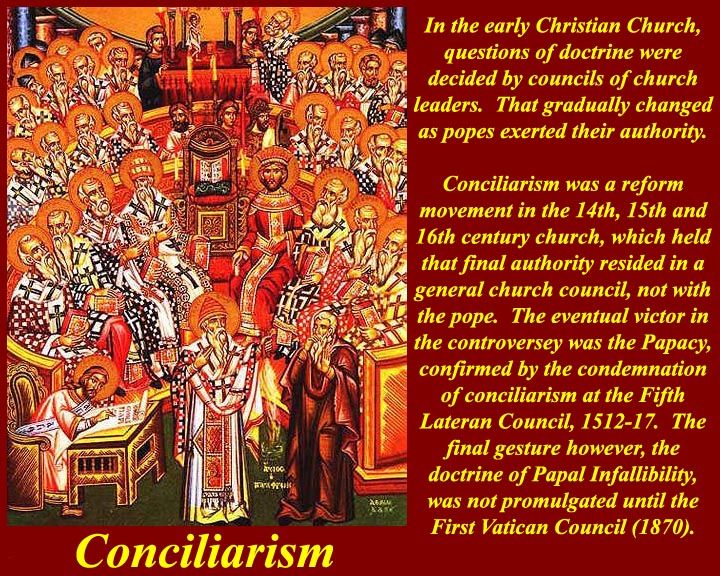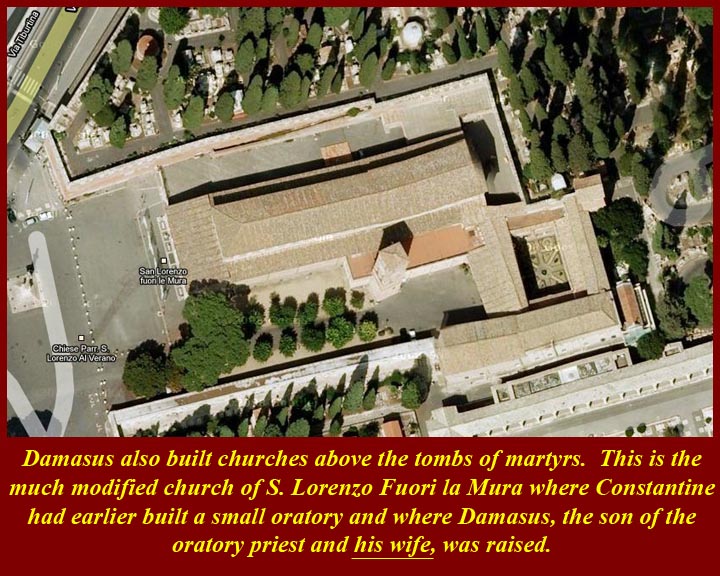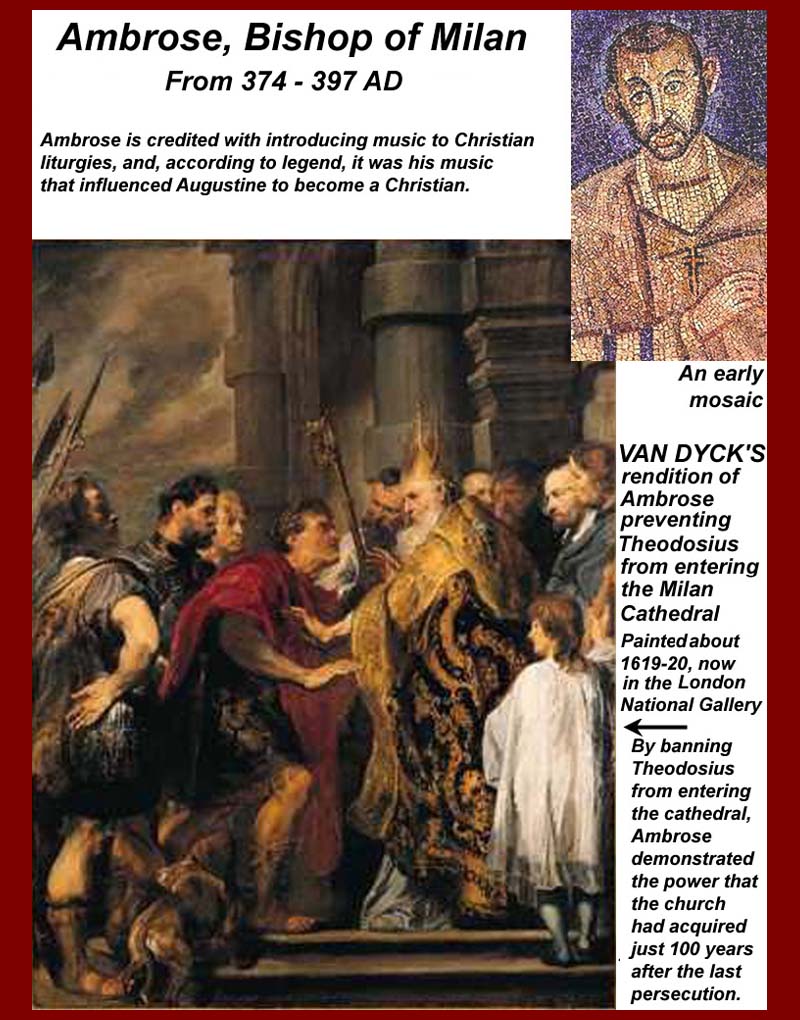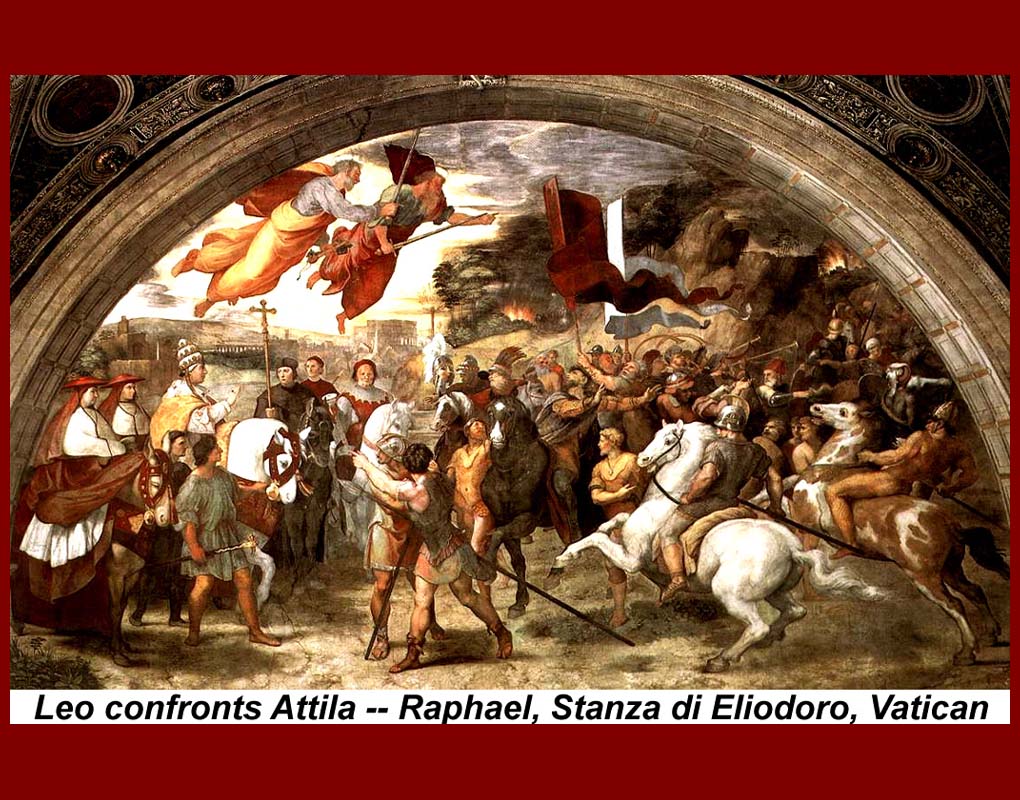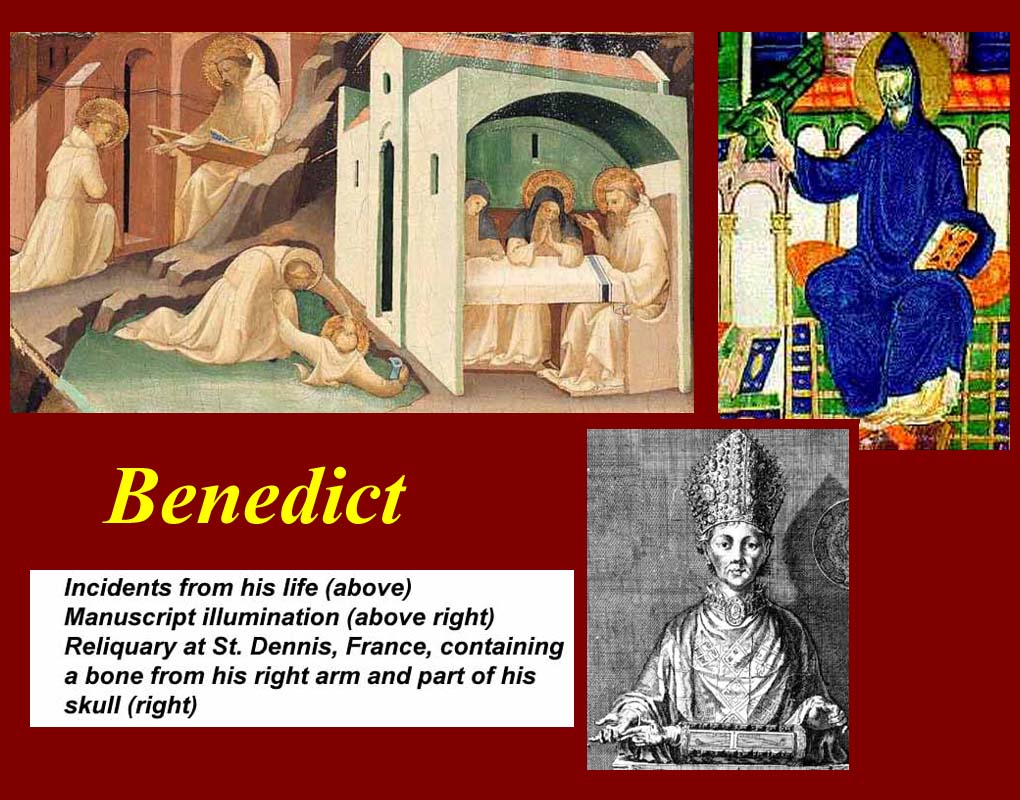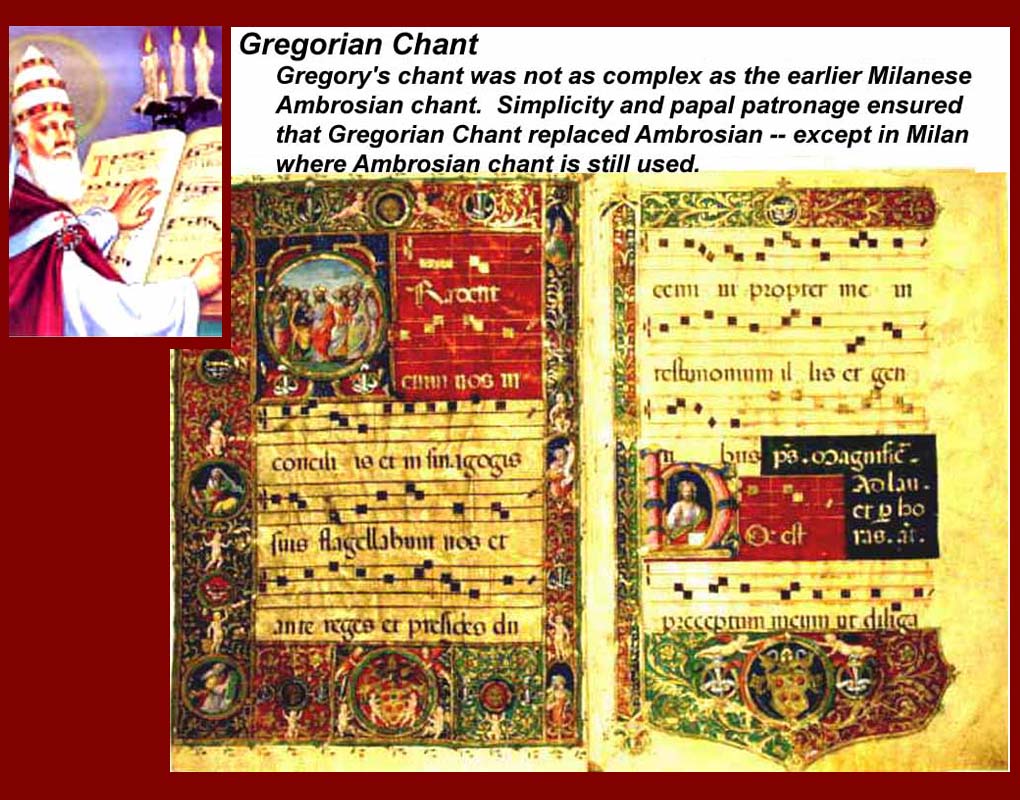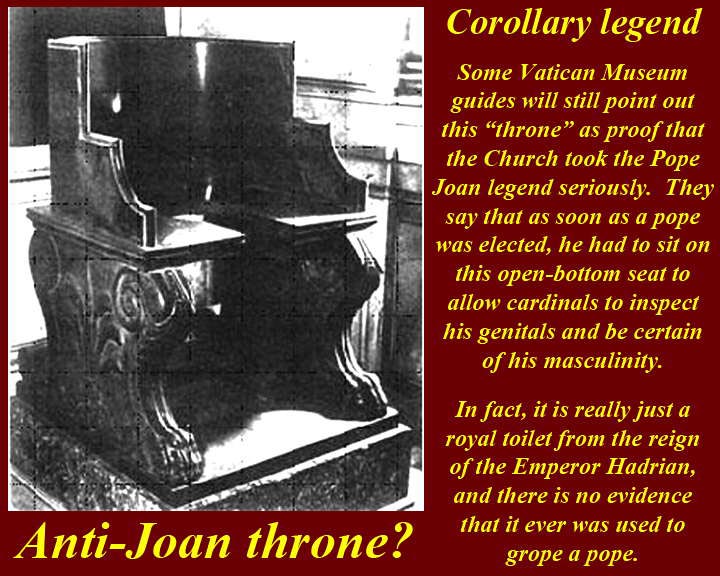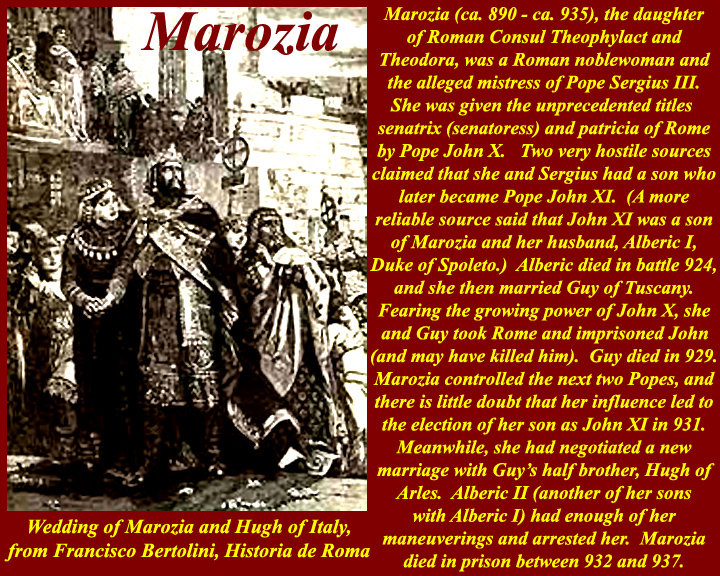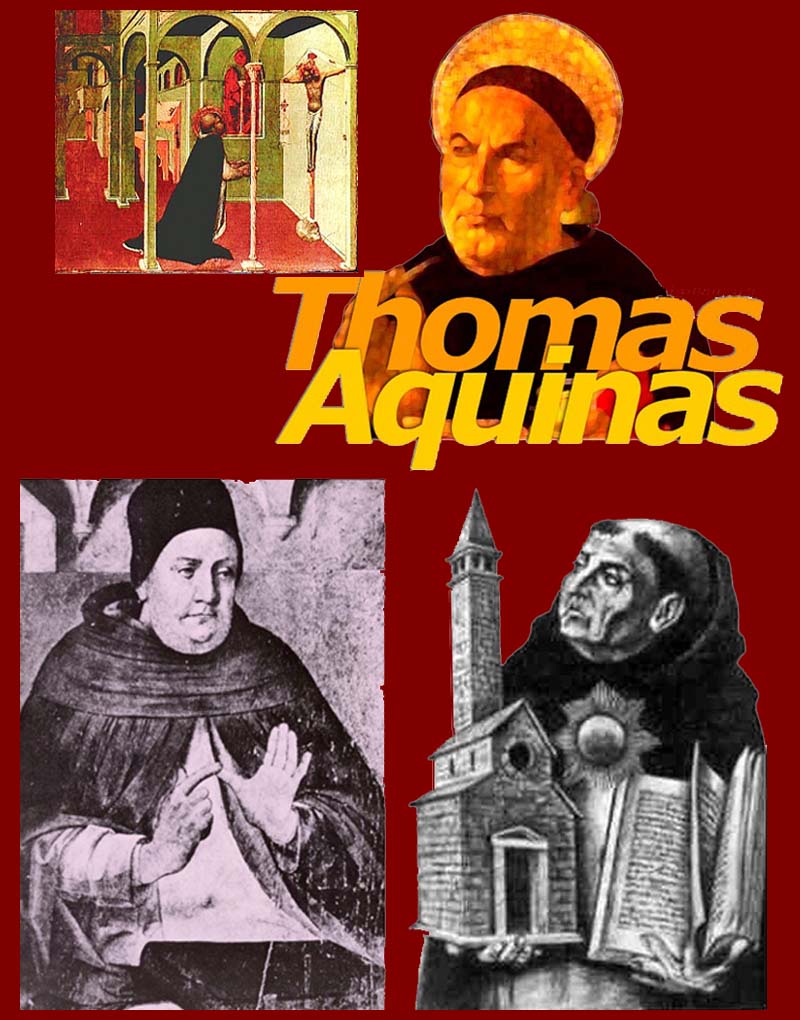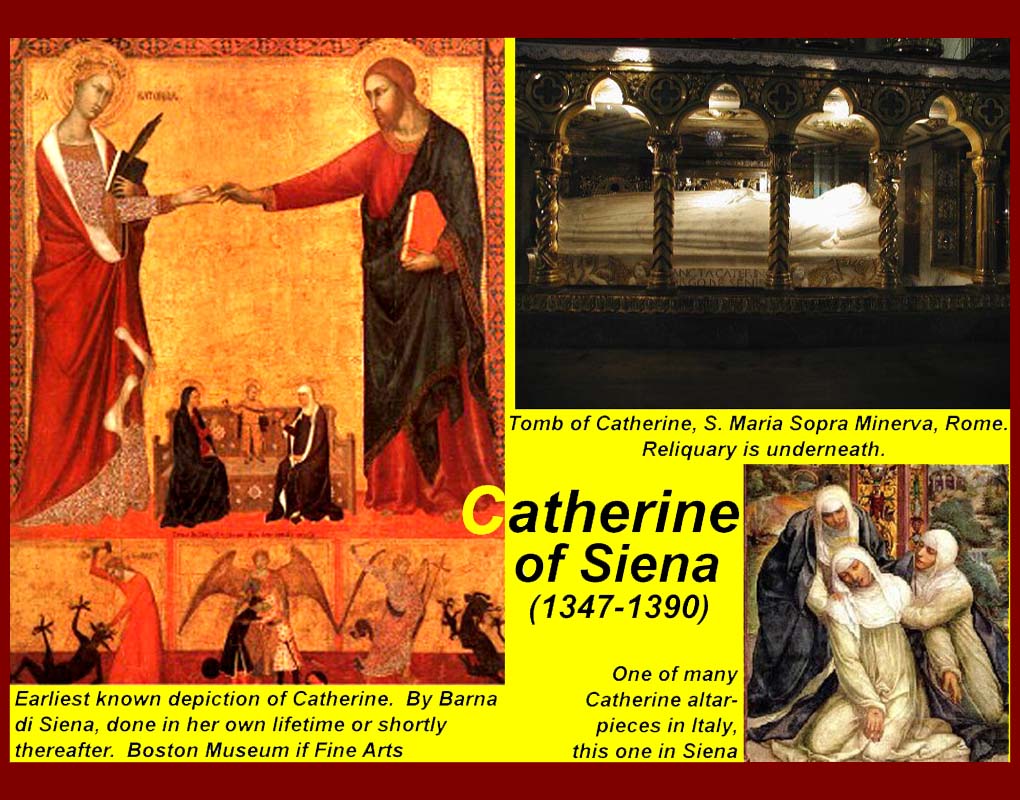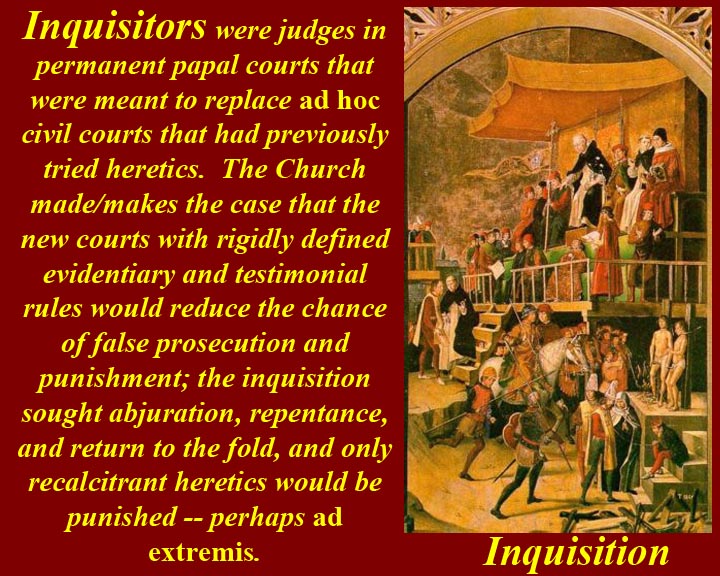The Christians take over
Click on the small images or links below to view larger images.
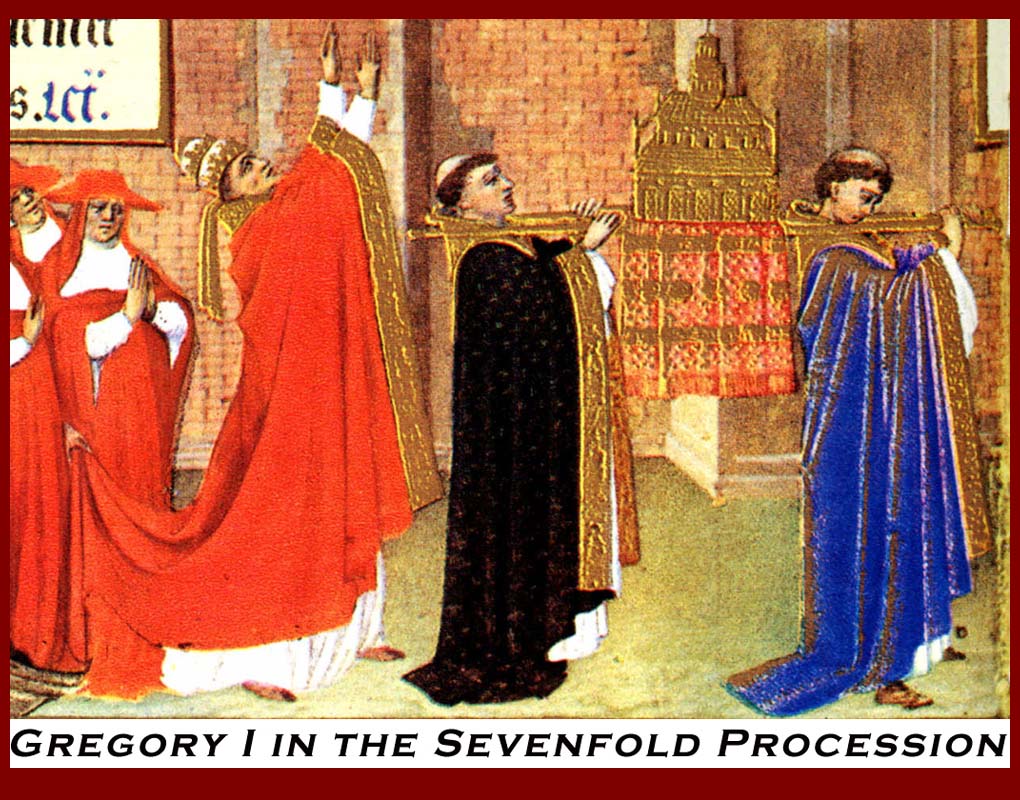
(also see below)
http://www.mmdtkw.org/MedRom0301GregoryProcession.jpg
http://www.mmdtkw.org/MedRom0312GregProcess.jpg (high resolution)Images: Gregory the Great in procession -- the end of the plague. Detail and entire page, Folio 71v of Les Très Riches Heures du Duc de Berry depicts Gregory leading a procession around the city to plead for respite from the plague. One of the monks has fallen to the illness. Les Très Riches Heures is a magnificent book of hours painted in the 15th century by the Limbourg Brothers and completed by Jean Colombe.
Gregory the Great (540-604 AD). In 590 AD, according to legend, shortly after reluctantly accepting the papacy, Gregory, led the "sevenfold procession" (so named because it was a confluence of processions originating in Rome's seven occupied regions). During the procession the people spotted the Archangel Michael on the pinnacle of Hadrian's tomb. The angel was sheathing his sword indicating that the plague that had afflicted Rome was at an end. Hadrian's Tomb has ever since been called Castel Sant'Angelo to commemorate the event.
Although not the first Pope to influence Medieval Rome, Gregory is considered to have had the greatest influence in shaping the early medieval papacy, which by default had inherited temporal power over Rome. For Gregory's bio and accomplishments, see http://en.wikipedia.org/wiki/Pope_Gregory_I, http://www.newadvent.org/cathen/06780a.htm, or http://catholicism.org/gregory-
great.html.
Angel statues were added (sequentially) to Hadrian's tomb during the Renaissance
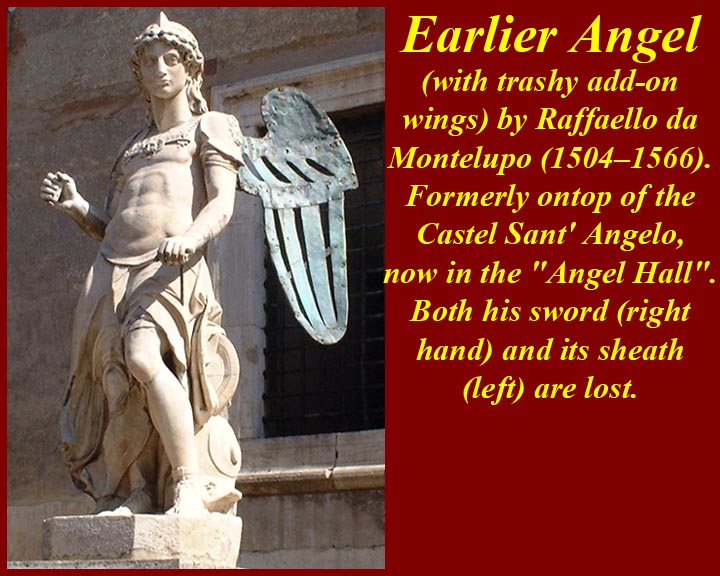
http://www.mmdtkw.org/MedRom0301xDaMontelupoSantangelo.jpg
http://www.mmdtkw.org/MedRom0301yMichaelSantAngelo.jpg
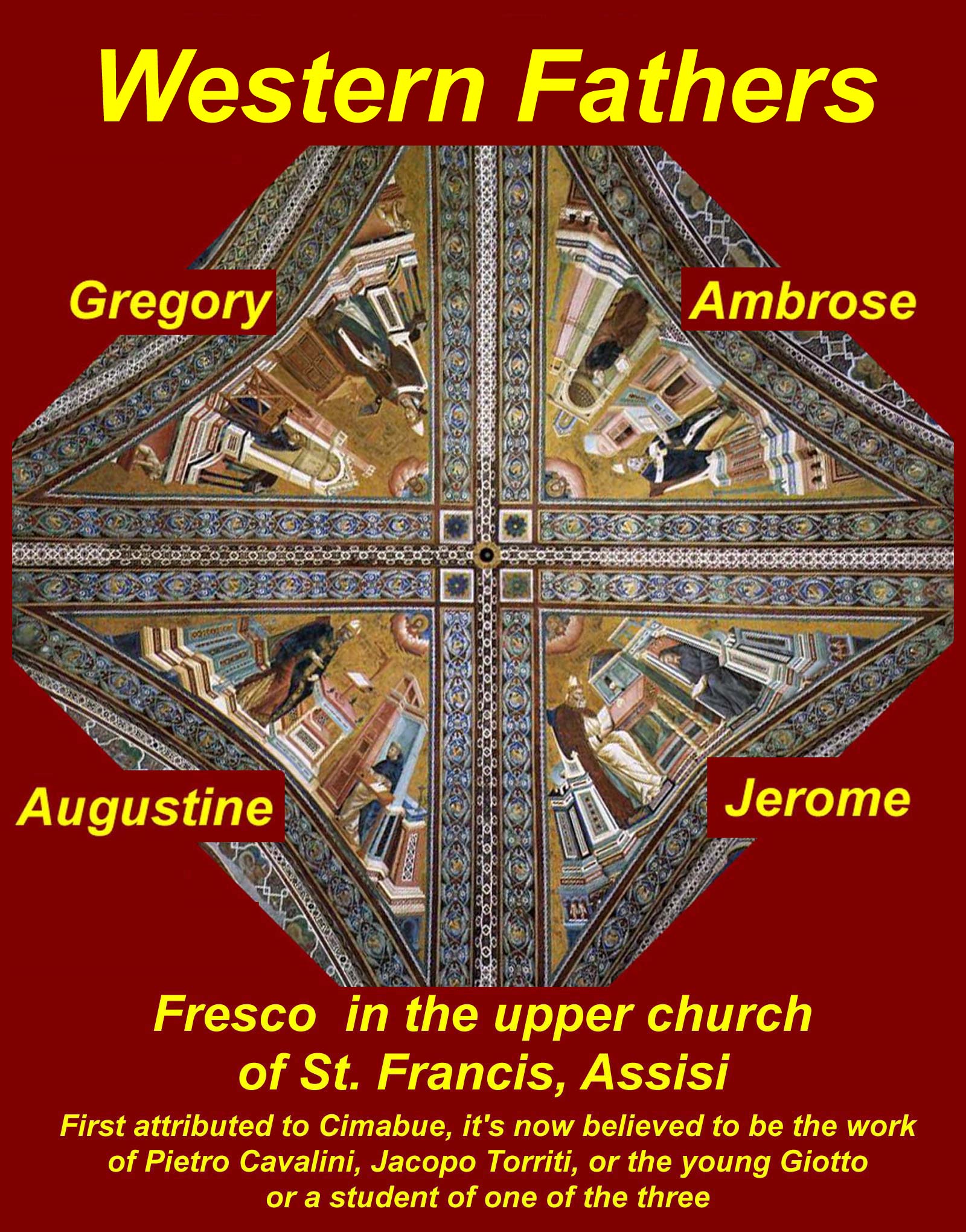
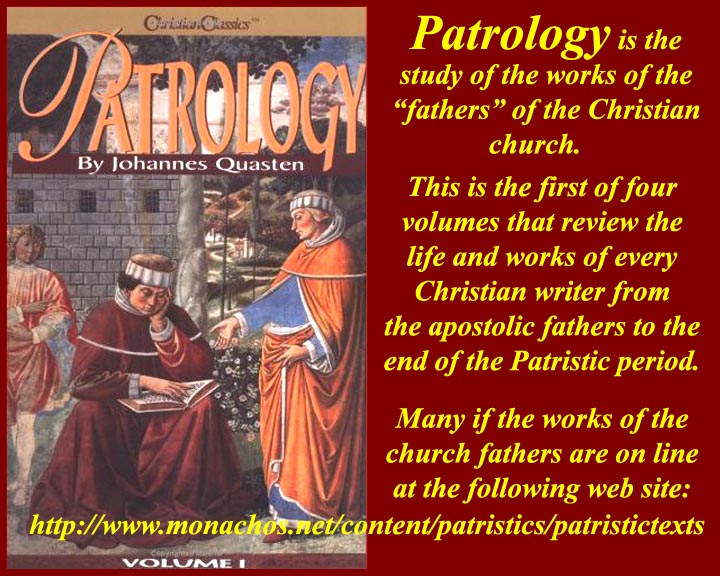
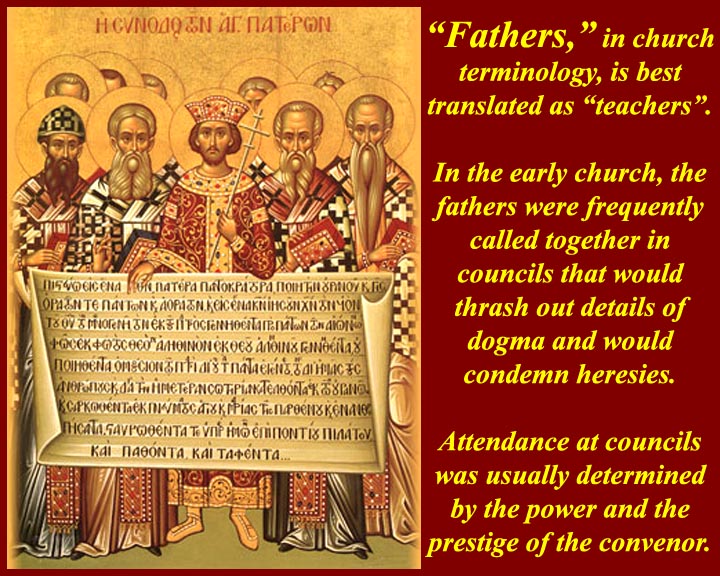
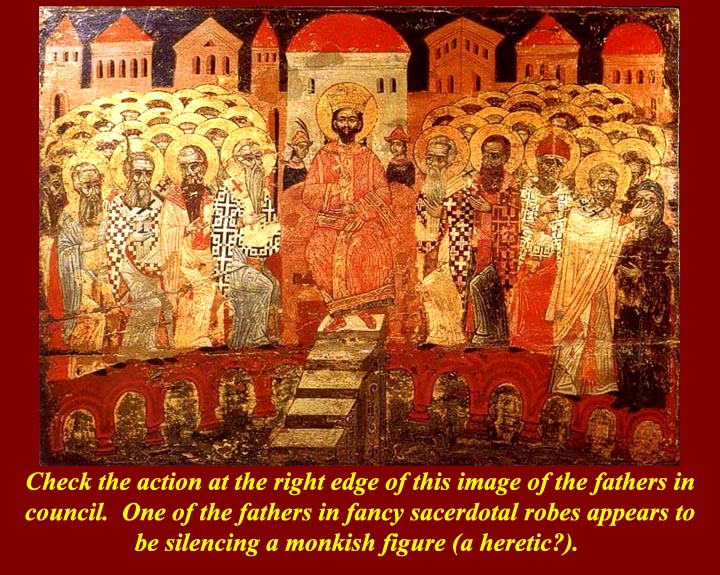
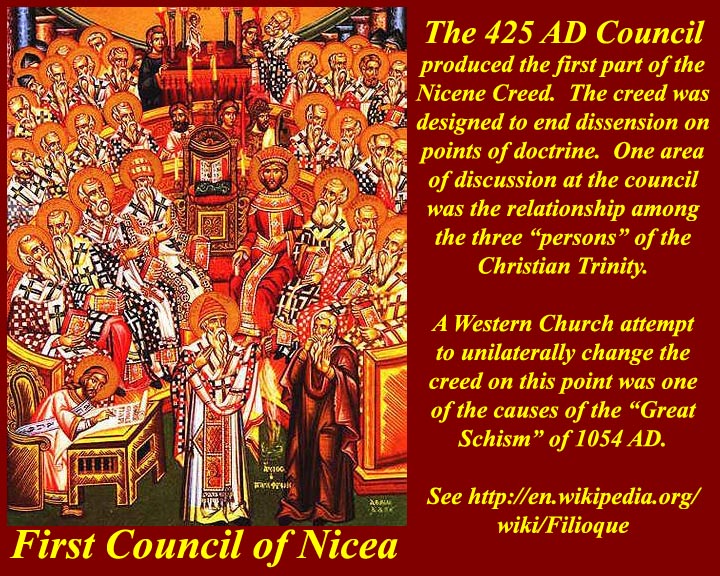
http://www.mmdtkw.org/MedRom0302aaWFathers.jpg
http://www.mmdtkw.org/MedRom0302abPatrology.jpg
http://www.mmdtkw.org/MedRom0302acNiceneFathers.jpg
http://www.mmdtkw.org/MedRom0302adFathersCouncil.jpg
http://www.mmdtkw.org/MedRom0302aeFirstNicea-Creed.jpg
http://www.mmdtkw.org/MedRom0302afConciliarism.jpg
Gregory, along with Ambrose, Jerome, and Augustine, was one of the four great Latin Fathers of the Church. There were other fathers in the Latin and Byzantine churches -- a short article on all the Church Fathers is at http://en.wikipedia.org/wiki/Church_Fathers.
There was no unanimity in the early Church on doctrine. Individual practitioners -- those who knew anything about the founders of the Church and the circumstances of its founding -- interpreted and expounded their theories for the benefit if the congregation. There were false starts and controversies -- and some actual battles -- that needed to be settled, and there was no executive to make decisions. Eventually, in an effort to quell the disputes, Councils were convened to try to reach consensus. In practice, consensus was never reached. What really happened was that a winning coalition (sometimes helped by the convening authority) would issue a decision and use it to hound and persecute the remainder. The persons who won the dispute that had precipitated the council were later called "Fathers of the Church", and those who weren't members of the winning coalition were called heretics.
Eventually, the popes accrued enough power, first, to referee church disputes themselves, and, second, to preempt them. In the late-medieval/early-renaissance period, "Conciliarism" or the "Conciliar Movement" tried to reassert authority of Councils (in reaction to perceived undue influence of the French monarchy over the Avignon popes). But in only a few hundred years, that rabbit was stuffed back into the hat when Conciliarism was condemned by the Fifth Lateran Council (1512-17), and the hat was finally put back on the magician's head when "papal infallibility" was promulgated at the First Vatican Council (1870).
http://www.mmdtkw.org/MedRom0302bPeterPaul.jpg
The first great controversy in the Christian church was between some Christians of Jerusalem (mostly converted Jews, who apparently believed you could only be a male Christian if you were already a circumcised Jew) and members of the Christian community centered in Antioch, supporters of Paul (who believed that male gentiles could become Christians without first becoming Jews through the ritual of circumcision and following other Torah traditions). The controversy was not long-lived. The standard medieval imagery of the Christian Church in Rome, as exemplified above, depicts unification of the James-the-Just/Peter (Jerusalem) tradition and Pauline (Antioch) tradition by seating both Peter and Paul at the sides of Christ. For information on the 50 AD Council of Jerusalem that settled the controversy, see http://en.wikipedia.org/wiki/Council_of_Jerusalem. (Note that most Christian authorities believe that this James, a leader of the early Christians in Jerusalem, was not, repeat not, the Apostle James. For information on this James, "the Just", see http://en.wikipedia.org/wiki/James_the_Just.) It is interesting that this controversy has re-emerged in modern times, but with a twist. Some Christians now actively oppose male circumcision on the grounds that you can't really be a Christian if you are circumcised. What people will argue about has always been amazing.
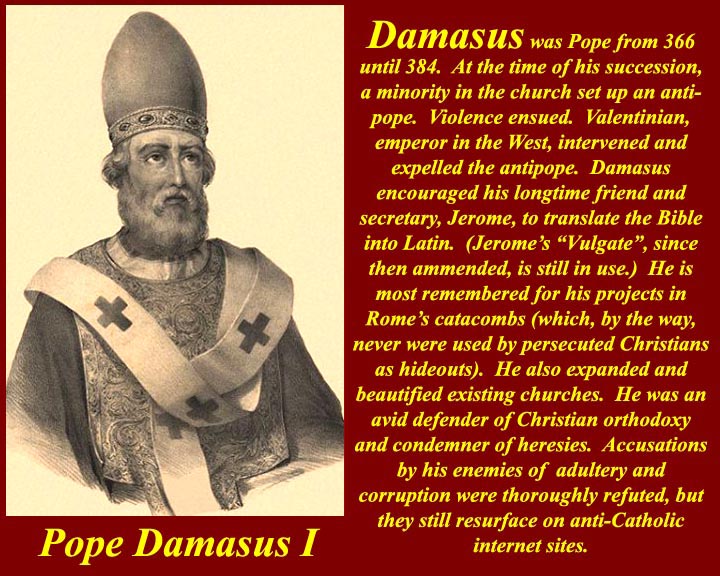
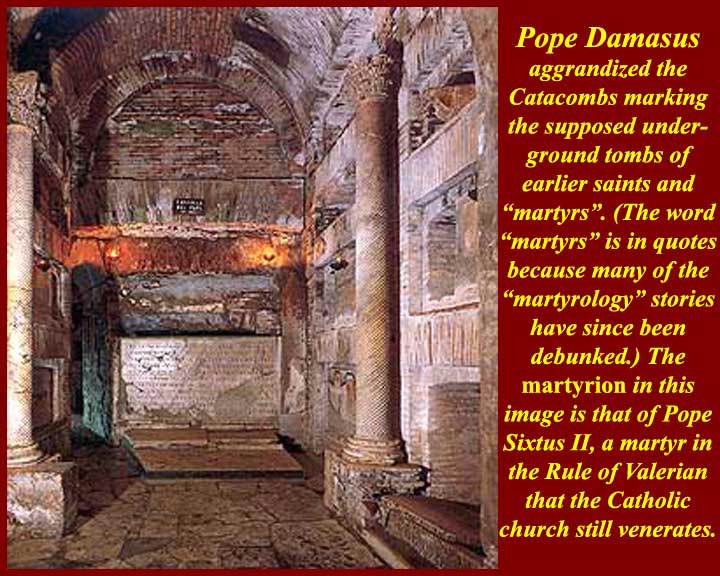
http://www.mmdtkw.org/MedRom0302cDamasusI.jpg
http://www.mmdtkw.org/MedRom0302cxCriptaSixtusII.jpg
http://www.mmdtkw.org/MedRom0302cyLorenzoFuori.jpg
Damasus (ca. 305-384 AD) was the son of the priest at the shrine of St. Laurentius (now S. Lorenzo Fuori la Mura) in Roma. His election to the papacy was marked by violence between his supporters and the supporters of his rival, Ursinus (or Ursicinus). Pope Damasus (elected 366, died 384) was accused in the massacre several hundred supporters of the man who had been his rival for succession to the papacy, but his upper class supporters suppressed the indictment. His succession appears to have been the most violent of any in church history. He went on to be a great defender of the church against heresies. Among the accomplishments credited to him were the commissioning of Jerome to do a new translation of the bible into Latin (based on the Greek New Testament and the Septuagint) and enrichment of Rome's Christian shrines and catacombs. For more details, see http://en.wikipedia.org/wiki/Pope_Damasus_I or http://www.newadvent.org/cathen/04613a.htm. For information of the Crypt of Sixtus II in the Callixtus catacombs, see http://www.catacombe.roma.it/en/cripta.html. For information on the church of S. Lorenzo Fuori la Mura, see http://www.sacred-destinations.com/italy/rome-san-lorenzo.
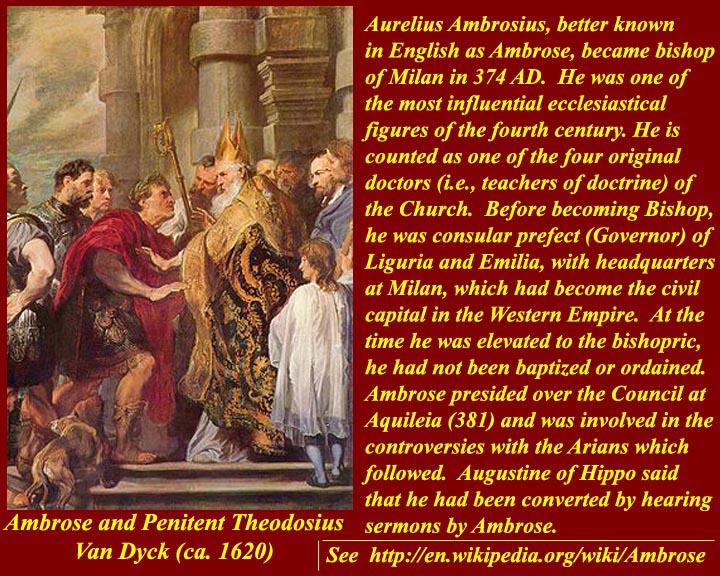
http://www.mmdtkw.org/MedRom0303aAmbrose.jpg
http://www.mmdtkw.org/MedRom0303AmbroseTheodos.jpg
Ambrose of Milan (339-397 AD) humiliates Theodosius. For the incident pictured and the events leading up to it, see http://www.fordham.edu/halsall/ancient/theodoret-ambrose1.html. For information on Ambrose, see http://en.wikipedia.org/wiki/Ambrose or http://www.newadvent.org/cathen/01383c.htm. For information on Theodosius, see http://en.wikipedia.org/wiki/Theodosius_I or http://www.newadvent.org/cathen/14577d.htm.
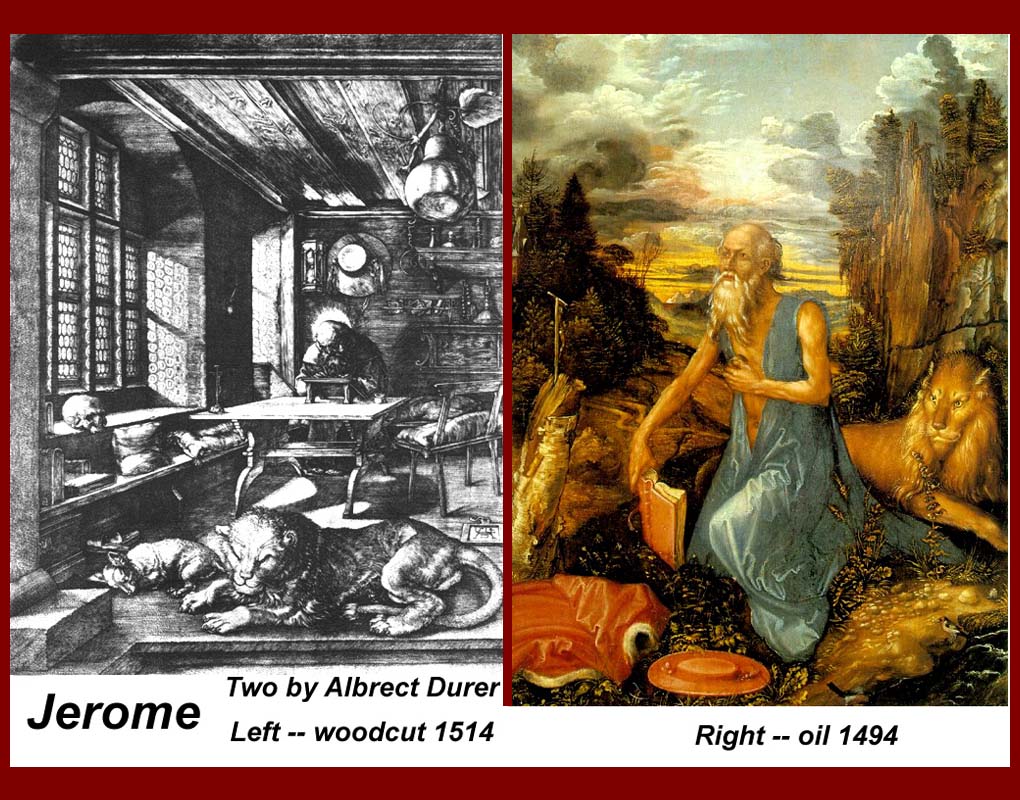
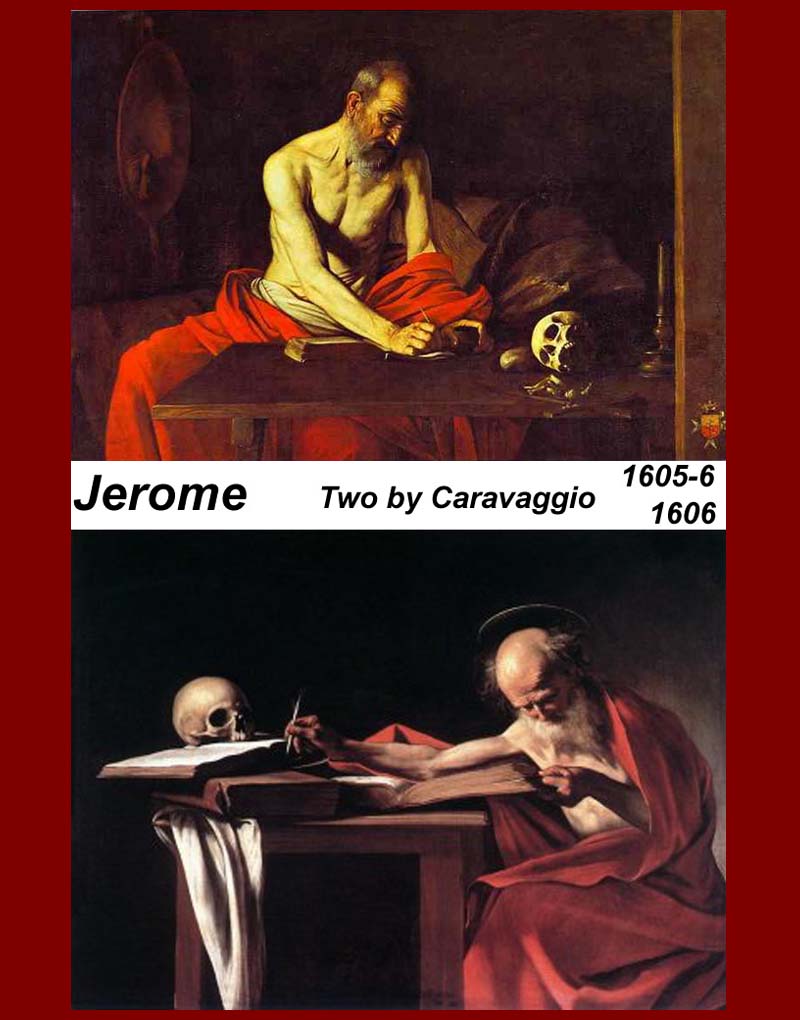
http://www.mmdtkw.org/MedRom0304JeromeDurer.jpg
http://www.mmdtkw.org/MedRom0305JeromeCaravaggio.jpg
Jerome the gadfly (347-420)- two by Durer and two by Caravaggio. Jerome was provocative in the worst possible Christian way; he constantly reminded other Christians that they did not and could not possibly live up to his own standards of Christian asceticism. It was possibly for this reason that Pope Damasus, who with his own rich friends was interested in living the good life in Rome, encouraged Jerome to leave Rome to complete his Latin translation of the Greek Old Testament and the Septuagint. Jerome went off to Bethlehem and, according to legend, finished his translations in a cave adjacent to the stable/cave where Christ was said to have been born. (You can visit both caves under the Church of the Nativity in Bethlehem.) The product, Jerome's Vulgate, has been much amended in the intervening centuries. Renaissance Latinists tried to upgrade the Vulgate into quasi-Ciceronian Latin (but is still retains much of Jerome's "vulgar" Latin), and modern Latinists decry the very "vulgarity", for which Jerome strove. His idea was to make the Bible accessible to the "common people" (= "vulgus" in Latin) who spoke only a degraded form of Latin. Jerome is often depicted with a human skull and a lion -- the skull because his cave had been used as a cemetery, and the lion because he supposedly tamed and befriended one by removing a thorn from its foot (something that appears to have happened frequently in ancient legends).
Jerome took with him to Bethlehem a coterie of women followers led by his friend and financiere Paula. There is no evidence of anything untoward in their relationship.
For information on Jerome, see http://en.wikipedia.org/wiki/Jerome or http://www.newadvent.org/cathen/08341a.htm or http://www.catholic.org/saints/saint.php?saint_id=10.
The story of the Lion is from the Golden Legend (1275 AD) by Jacobus de Voragine. A translation of de Voragine's tale can be accessed at http://www.fisheaters.com/animals3.html. (c.f., The Paradox of Jerome’s Lion at http://www.poetryfoundation.org/archive/poem.html?id=181971.
For information on Paula, see http://en.wikipedia.org/wiki/Saint_Paula.
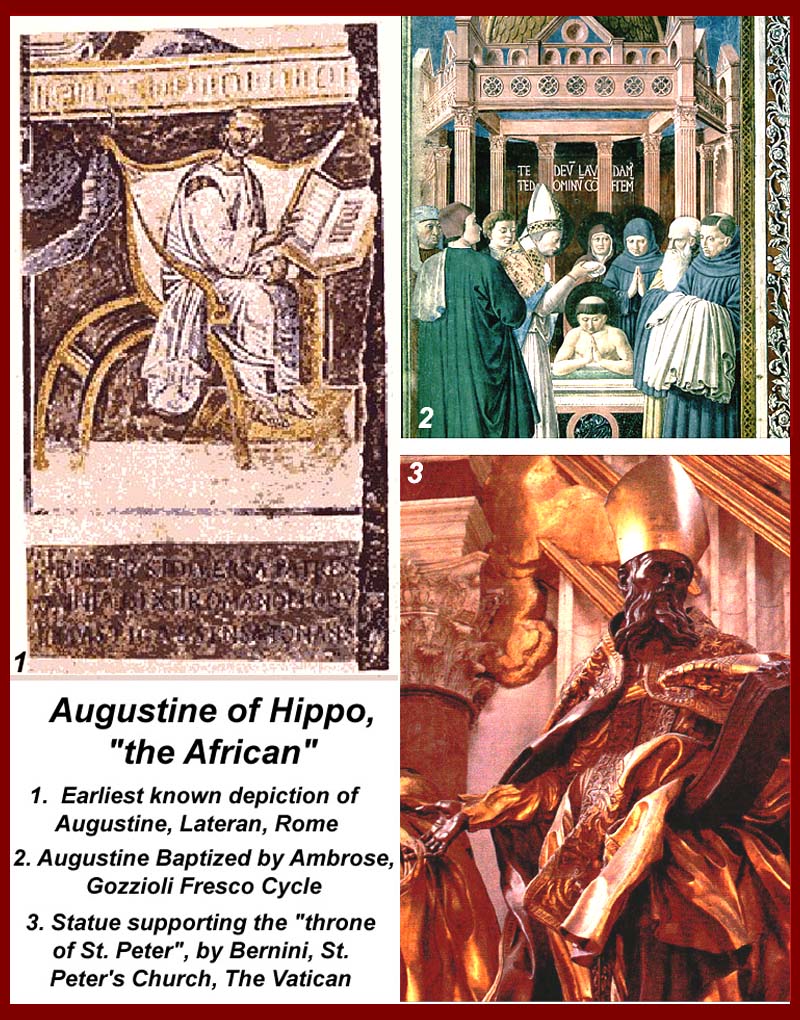
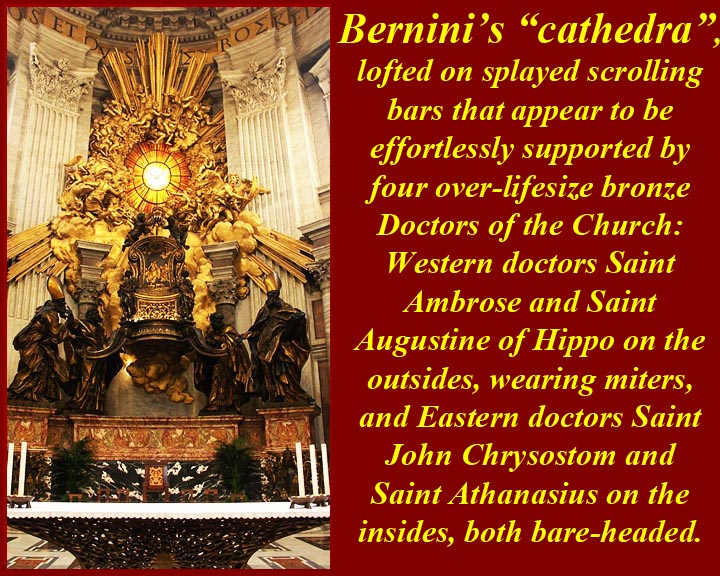
http://www.mmdtkw.org/MedRom0306Augustine.jpg
http://www.mmdtkw.org/CathedraPetri-Bernini.jpg
Augustine the African (354-480 AD). Augustine of Hippo was the Christian bishop of Hippo Regius in the Roman Africa Province. He was a Latin-speaking philosopher and theologian whose writings were very influential in the development of Western Christianity. He "established anew the ancient faith" ("conditor antiquae rursum fidei"), according to his contemporary, Jerome. In his early years he was heavily influenced by Manichaeism and afterward by the Neo-Platonism of Plotinus, and, according to his own Confessions, led a wild early life. After his conversion to Christianity (after listening to Ambrosian Chant in the Milan cathedral, he said) and baptism in 387, Augustine developed his own approach to philosophy and theology, accommodating a variety of methods and different perspectives. He believed that the grace of Christ was indispensable to human freedom, and he framed the concepts of original sin and just war.
When the Roman Empire in the West was starting to disintegrate, Augustine developed the concept of the Church as a spiritual "City of God" (in a book of the same name), distinct from the material Earthly City. His thought profoundly influenced the medieval worldview. Augustine's City of God was closely identified with the church as the community that worshiped God.
In the Catholic Church and the Anglican Communion, he is a saint and a pre-eminent Father/Doctor of the Church, and the patron of the Augustinian religious order. He also is the patron saint of brewers, printers, theologians, sore eyes, and a number of cities and Anglican and Catholic dioceses. Many Protestants, especially Calvinists, consider him to be one of the theological fathers of Reformation due to his teaching on salvation and divine grace.
For more information on Augustine, see http://en.wikipedia.org/wiki/Augustine_of_Hippo or http://www.newadvent.org/cathen/02084a.htm. A full text English translation of Augustine's Confessions is at http://www.stoa.org/hippo/, and his City of God is available in English at http://www.newadvent.org/fathers/1201.htm.
The Catholic Church acknowledges that the so-called Chair of St. Peter, enshrouded in Bernini's gilded bronze, actually dates from no earlier than the sixth century.
(a)
(b)
http://www.mmdtkw.org/MedRom0307LeoAtilla.jpg
http://www.mmdtkw.org/MedRom0308LeoAtillaRaphael.jpg
Leo I, The Great (400-461 AD). Images:(a) Leo and Attila, AlGardi sculpture, St. Peter's, Vatican and (b) Leo and Attila, Raphael Stanza of Heliodorus, Papal Palace, Vatican.
Leo is best known for convincing Attila not to take Rome (by miracle, bribe, or the threat of Aetius), but he also was a significant contributor to the centralization of spiritual authority within the Church and in reaffirming Papal authority. While the Bishop of Rome had always been viewed as the chief patriarchate, much Papal authority had been delegated to local diocesan bishops. Despite serious opposition he succeed in clawing back his authority. For a simple contemporary account of the Leo-Attila encounter followed by a embroidered later miraculous account, see http://www.fordham.edu/halsall/source/attila2.html. For more information about Leo's life and accomplishments, see http://en.wikipedia.org/wiki/Pope_Leo_I or http://www.newadvent.org/cathen/09154b.htm.
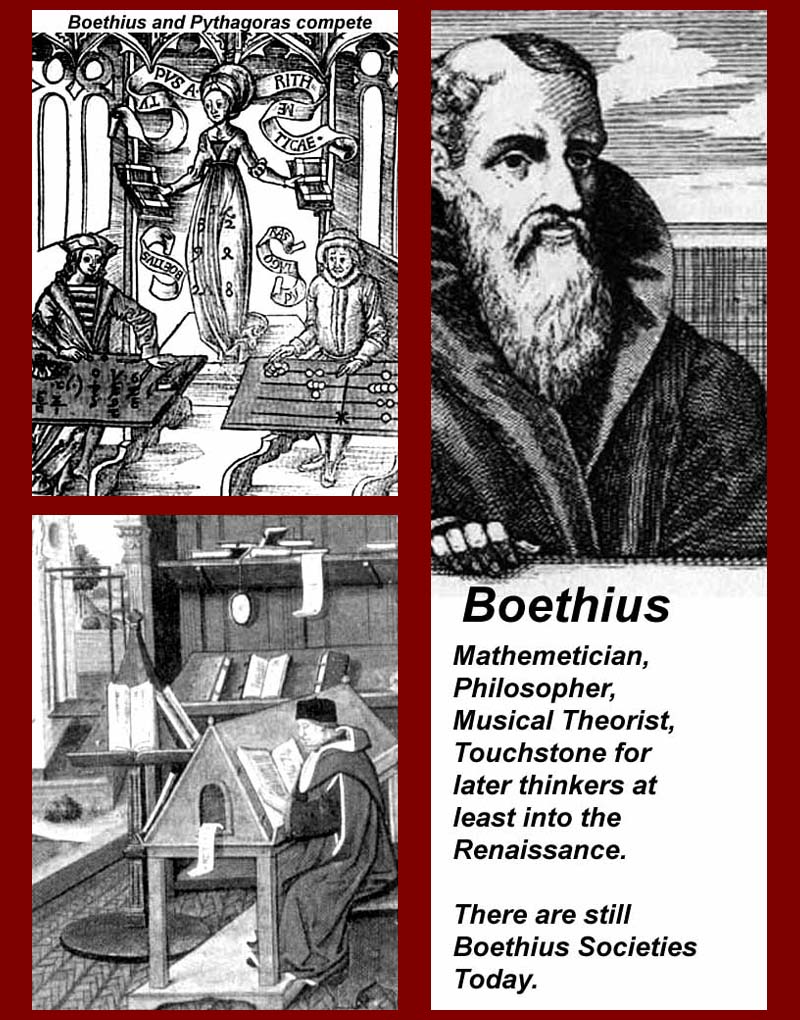
http://www.mmdtkw.org/MedRom0309Boethius.jpeg
Boethius (ca. 480–524 or 525) -- new math overcomes Pythagoras.
Anicius Manlius Severinus Boëthius, commonly called Boethius was a Christian philosopher of the early 6th century. He was born in Rome to an ancient and important family which included emperors Petronius Maximus and Olybrius and many consuls. His father, Flavius Manlius Boethius, was consul in 487 after Odoacer deposed the last Western Roman Emperor. Boethius, of the noble Anicius lineage, entered public life at a young age and was already a senator by the age of 25. Boethius himself was consul in 510 in the kingdom of the Ostrogoths. In 522 his two sons became consuls. Boethius was executed by King Theodoric the Great, who suspected him of conspiring with the Byzantine Empire. While imprisoned prior to his execution, Boethius wrote his Consolation of Philosophy.
Boethius is also famous for his books which revolutionized mathematics (and music as a mathematical construct). He is thought to have been the first Western mathematician who calculated using pure numbers rather than calculating using tokens (i.e., counting things or things representing things or groups of things as with an abacus) and the first to introduce Arabic numbers (which had the advantage of having a glyph/symbol for "zero") although some scholars maintain the the Aritmetica of Boethius was based almost entirely on the Introduction to Arithmetic by Nichomachus (c. 60 – c. 120). Regardless of whether his theories were original, the mathematical works of Boethius were the standards referenced during the Western European Medieval period. He also began the study of the relationship of music and mathematics, having determined that sound was caused by vibrations in air (work that was essentially completed by Vincenzo Galilei, a famous lutenist, composer, and music theorist and the father of Galileo Galilei, the astronomer.)
For more information on Boethius, see http://en.wikipedia.org/wiki/Boethius or http://www.newadvent.org/cathen/02610b.htm. For information on Nichomachus, see http://en.wikipedia.org/wiki/Nicomachus. The works of both men can be purchased from online booksellers.
http://www.mmdtkw.org/MedRom0310Benedict.jpg
Benedict of Nursia (480-547 AD) -- Benedict of Nursia founded twelve communities for monks at Subiaco, about 40 miles to the east of Rome, before moving to Monte Cassino in the mountains of southern Italy. There is no evidence that he intended to found a religious order. The Order of St Benedict is of modern origin and, moreover, not an "order" as commonly understood but merely a confederation of autonomous congregations.
Benedict's main achievement is his "Rule", containing precepts for his monks. It is heavily influenced by the writings of John Cassian, and shows strong affinity with the Rule of the Master (an anonymous sixth-century collection of monastic precepts). But Benedict's rule also has a unique spirit of balance, moderation and reasonableness (ἐπιείκεια, epieikeia), and this persuaded most religious communities founded throughout the Middle Ages to adopt it. As a result, the Rule of Benedict became one of the most influential religious rules in Western Christendom. For this reason Benedict is often called the founder of western Christian monasticism. There are Roman Catholic, Anglican, and independent "Benedictine" communities.
For more information on Benedict, see http://en.wikipedia.org/wiki/Benedict_of_Nursia and http://www.newadvent.org/cathen/02467b.htm. Benedict's Rule is on line in several places -- just search for Benedict and rule. Benedictine organization is expounded at http://en.wikipedia.org/wiki/Benedictine_Confederation.
For Dominic and Francis, the founders of the late medieval monastic orders, see Unit 5 of this course at http://www.mmdtkw.org/MedRomUnit0500-0PixList.html.
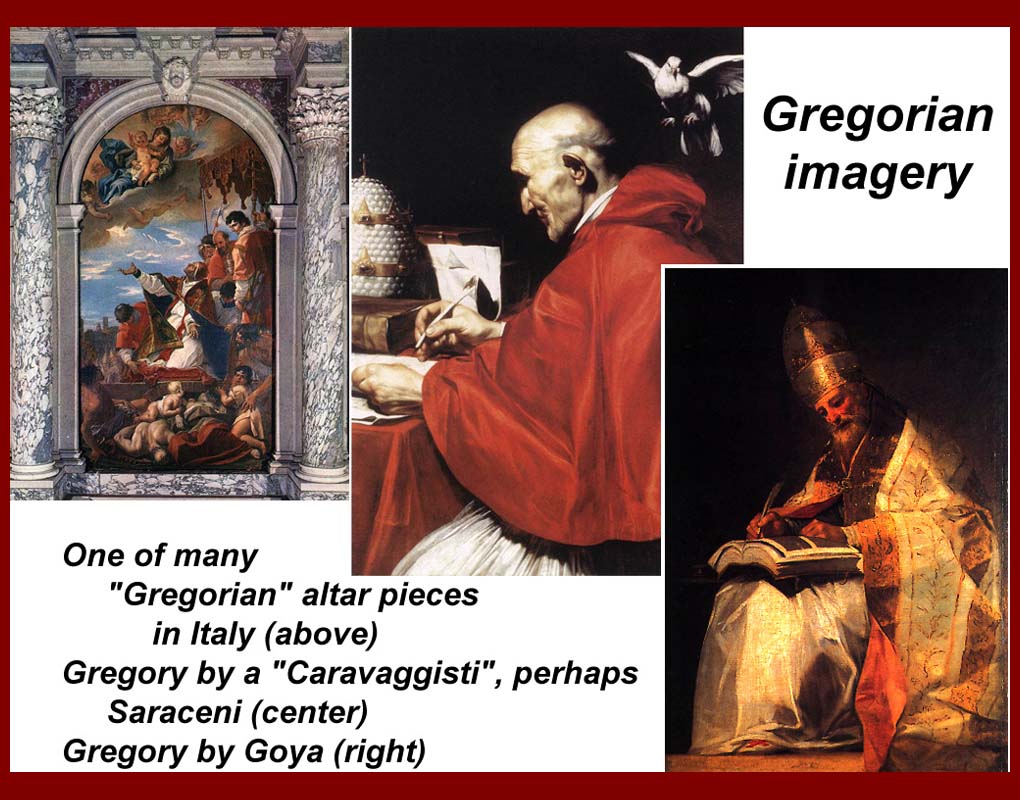
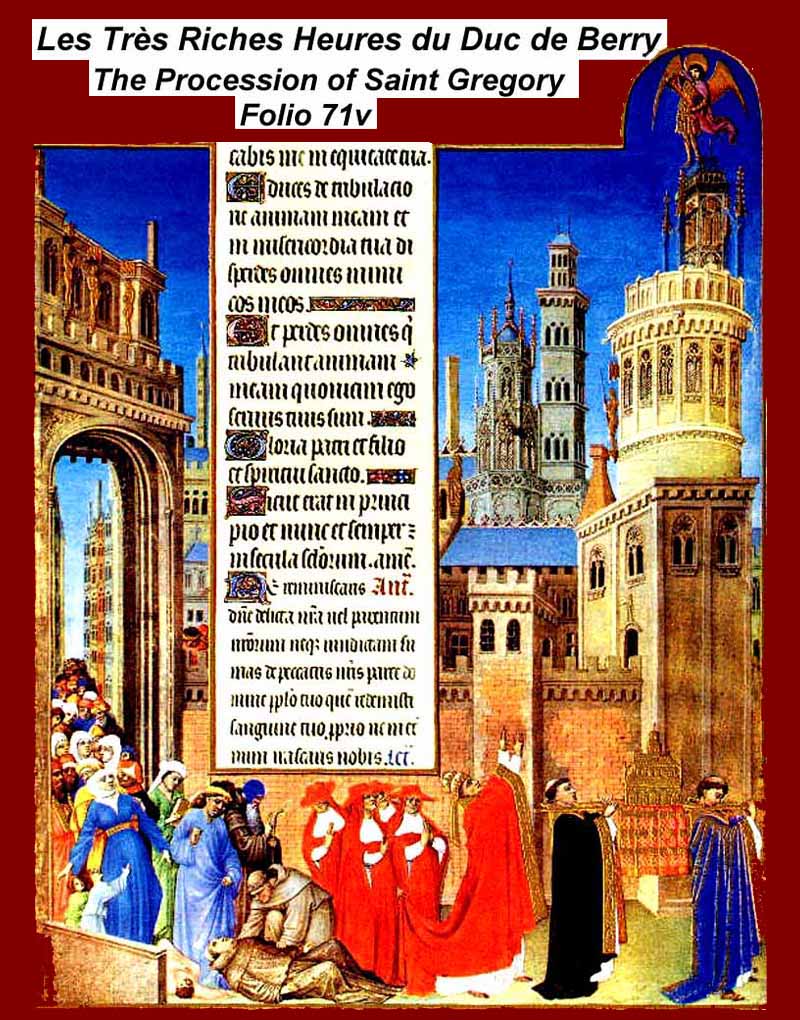
http://www.mmdtkw.org/MedRom0311GregoryImagery.jpg
http://www.mmdtkw.org/MedRom0312GregProcess.jpg
http://www.mmdtkw.org/MedRom0313GregorianChant.jpg
Gregory the Great (540-604 AD). Gregory the Great was pope from 3 September 590 until his death. He is well-known for his writings, which were more prolific than those of any of his predecessors as pope.
He is also known as St. Gregory the Dialogist in Eastern Orthodoxy because of his Dialogues. For this reason, English translations of Orthodox texts will sometimes list him as "Gregory Dialogus". He was the first of the popes to come from a monastic background -- he wrote a biography of Benedict, so he is thought to have followed Benedict's Rule. Gregory is a Doctor of the Church and one of the six Latin Fathers. He is considered a saint in the Roman Catholic Church, Eastern Orthodox Church, Anglican Communion, and some Lutheran churches. Immediately after his death, Gregory was canonized by popular acclaim. John Calvin admired Gregory and declared in his Institutes that Gregory was the last good pope.
English-speaking Christians will also remember Gregory for sending a party of missionaries headed by Augustine of Canterbury (not to be confused with the more famous Augustine of Hippo) to preach the Gospel to the pagan Anglo-Saxon tribes that had invaded England and largely conquered or displaced the Celtic Christians previously living there.
He is the patron saint of musicians, singers, students, and teachers. (It should be noted that modern scholars believe that England was already Christian, having been converted by Irish monks, when Augustine arrived and that the myth of Augustine "Christianizing" England was a way to bring British Christians more closely under Roman papal control.)
See above for the Sevenfold Procession and the appearance of Michael the Archangel on Castel Santangelo. For more information on Gregory http://en.wikipedia.org/wiki/Pope_Gregory_I or http://www.newadvent.org/cathen/06780a.htm or http://justus.anglican.org/resources/bio/120.html.
For Augustine of Canterbury, see http://en.wikipedia.org/wiki/Augustine_of_Canterbury.
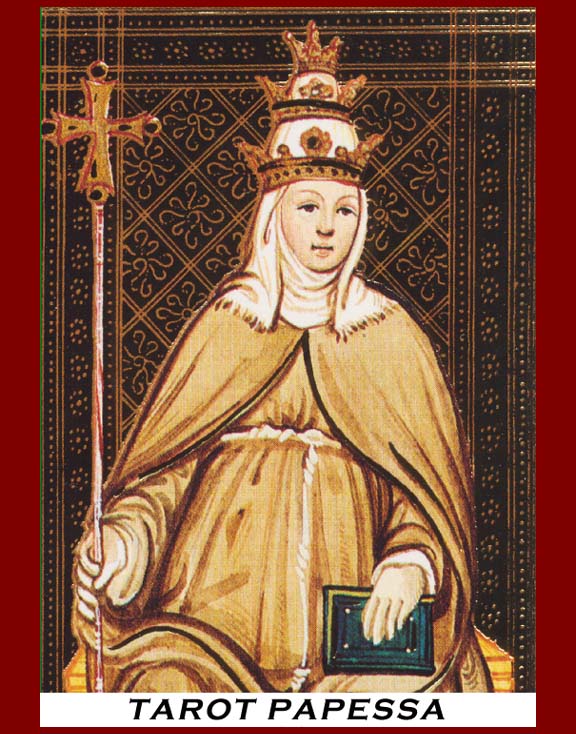
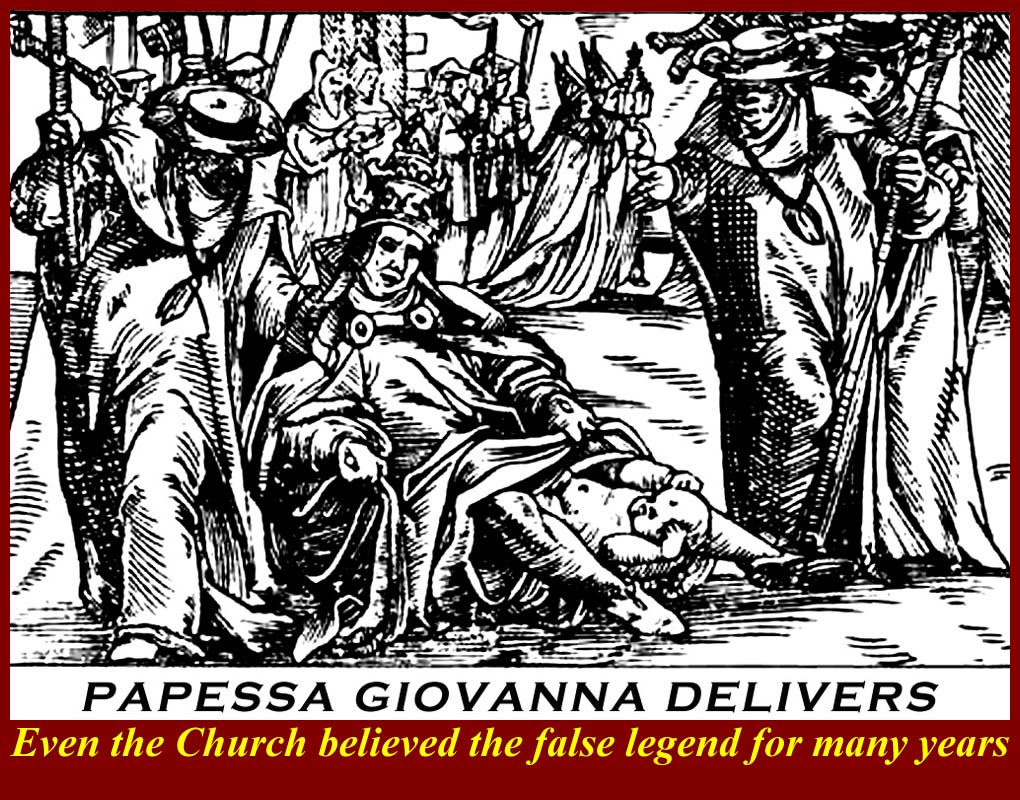
http://www.mmdtkw.org/MedRom0314TarotPapessa.jpg
http://www.mmdtkw.org/MedRom0315PapessaDelivers.jpg
http://www.mmdtkw.org/MedRom0315xGropeThrone.jpg
Pope Joan (9th or 11th century) -- a mythical female pope who supposedly gave birth during her coronation progress toward St. John Lateran church (somewhere between the Colosseum and S. Clemente. For a time, the Church apparently believed that she had existed, but there never was any historical evidence. She later appeared as the female pope in the Tarot deck and still appears today in anti-Catholic propaganda.
Supposed papal groping is also a myth. Stone thrones with strategically placed holes in their seats were not designed to check out papal genitals to insure maleness. In fact, they are thrones of a different kind, i.e., commodes. The thrones predate the dates attached to the Pope Joan legend and may well have had pride of place in Roman imperial privies. The holey throne in the Vatican museum (shown) dates to the reign of Hadrian.
For more information on the "Pope Joan" legend, see http://en.wikipedia.org/wiki/Pope_Joan or http://www.churchinhistory.org/pages/booklets/popejoan.pdf (requires a .pdf reader software program in your computer).
http://www.mmdtkw.org/MedRom0318Marozia_bertolini.jpg
Marozia of the Roman Crescentii family (ca.890-ca.935 AD), during the period when Roman nobles took over the elections of the Popes. Marozia, the daughter of Roman Consul Theophylact and Theodora, was a Roman noblewoman and the alleged mistress of Pope Sergius III. She was given unprecedented titles -- "Senatorix" and "Patricia of Rome" (the latter of which can only be translated as "female Patrician -- father -- of Rome") -- by Pope John X. Two very hostile sources claimed that she and Sergius had a son, who would later become Pope John XI. But a more reliable source said that John XI was the son of Alberic I, Duke of Spoleto, Marozia's husband. Alberic died in battle in 924, and Marozia then married Guy of Tuscany. Fearing the growing power of John X, she and Guy took over Rome and imprisoned John (and, according to some sources, killed him). Guy died in 929. Marozia controlled the next two popes, and there is little doubt that her influence led to the election of her son as John XI in 931. Meanwhile, Marozia had negotiated a new marriage with Guy's half brother, Hugh of Arles. Alberic II, another of Marozia's sons with her first husband, Alberic I, tired of her maneuverings and arrested her. She died in prison sometime between 932 and 937.
9th and 10th century Church history is extremely murky; contemporary "historians" and "diarists" were all beholden to the various Roman noble families that contended for control of the city and the papacy, so their accounts are extremely biased. (More recent "popular historians" with pro- and anti-Catholic axes to grind continue the confusion.) All that can really be said is that the period was very chaotic and confusing. The chaos surrounding the papacy continued until the popes became "captives" of refugees in Avignon.
The Marozia story at various times has become conflated with the story of Pope Joan -- just adding to the confusion.
Projecting two versions of the Marozia story are
http://en.wikipedia.org/wiki/Marozia,
http://en.wikipedia.org/wiki/Saeculum_obscurum.
http://www.mmdtkw.org/MedRom0316Aquinas.jpeg
Thomas Aquinas (1225-1274 AD) -- last great pre-humanist? Humanists were distinguished by their study of and writings about human affairs. Aquinas belonged to the earlier Deist tradition; he wrote about God. What distinguished him from most of his predecessors was his willingness to study God logically; he wanted to use logic to prove the existence of God. You could say that Thomas "lost his faith"; faith is the belief in the unprovable, or, said another way, once you can prove something you can no longer believe it. (Jesuits really love that kind of argument.) Thomas's use of logic (rather than faith) was condemned by the Bishop of Paris as an introduction of Aristotelianism and the more extreme Averroism. Some protestants still condemn Thomism for the same reason.
But Thomas won out within the Catholic Church. The father of the Thomistic school of philosophy and theology is now considered to have been the foremost classical proponent of natural theology. His influence on Western thought is considerable, and much of modern philosophy was conceived as a reaction against, or as an agreement with, his ideas, particularly in the areas of ethics, natural law and political theory. One of the 33 Doctors of the Church, he is now considered the Church's greatest theologian and philosopher. Pope Benedict XV, no mean logician in his own right, declared: "The Church has declared Thomas' doctrine to be her own". Aquinas is held in the Catholic Church to be the model teacher for those studying for the priesthood. The works for which he is best-known are the Summa Theologica and the Summa Contra Gentiles.
The main field of Thomas's activities was the University of Paris, but he conceived and wrote the first part of his Summa Theologic in the S. Sabina Dominican monastery on the Aventine Hill in Rome.
Thomistic philosophy and theology suffered a brief eclipse when, in 1349, the Plague swept through Paris wiping out most of the faculty and students at the University of Paris where he had taught. Thomism was revived by the Dominicans during the Renaissance and also took hold among the Jesuits during the Counter-Reformation.)
For a short vita of Thomas, see http://en.wikipedia.org/wiki/Thomas_Aquinas or
http://plato.stanford.edu/entries/aquinas/ or http://www2.nd.edu/Departments/Maritain/etext/stthomas.htm. An English translation of the whole of the Summa Theologica is at http://www.newadvent.org/summa/.
http://www.mmdtkw.org/MedRom0317CathSiena.jpg
Catherine of Sienna (1347-1380 AD) -- Mystic or "holy anorexic? The Catholic church has always maintained that Catherine was a philosopher, theologian, and mystic. In recent years, however, an alternate "rationalist" view has characterized her as an anorexic whose ecstasies were triggered by self starvation. (Anorexia of this type, predominantly in women and girls of the Medieval period, is called anorexia mirabilis -- miraculous sell-starvation -- rather than anorexia nervosa.) The "mystic" argument is available on the internet at http://www.newadvent.org/cathen/03447a.htm and http://en.wikipedia.org/wiki/Catherine_of_Siena and numerous other Internet sites. The case for anorexia is available at http://www.albany.edu/scj/jcjpc/vol8is1/reda.html and at http://www.stepbystep.com/Saintly-Sickness-Catherine-of-Siena-as-a-Prototype-of-Holy-Anorexia-165626/ and numerous other sites.
It should be noted that self starvation to promote mystical experience had a long tradition prior to, through, and beyond the Medieval period. It is cited in Egyptian pharaohs, in the recorded fasting in the desert by John the Baptist, Jesus, and Mohamed, and in the medieval fasts of women like Catherine and men like Francis of Assisi and many more. Also to be noted is the fact that, especially after the Medieval period, fasting women were more often accused of being witches or were said to be possessed by devils; there are additional theories that this later suppression and persecution of fasting women had much to do with assertion of male domination and removal of spiritual influence from women.
Regardless of whether Catherine was a mystic or an anorexic, she was taken seriously in her own time. She corresponded with kings, popes, nobles, and notables, and she was a member of a delegation from Rome which visited Avignon in 1376. She is said to have told Pope Gregory XI that he had no business to live away from Rome. He heeded her advice, and moved the papacy back to Rome. She then acted as the papal ambassador to Florence, and was able to reconcile a quarrel between the Pope and the leaders of that city. She then retired to Sienna, where she wrote her Dialog (full English translation), an account of her visions and other spiritual experiences, with advice on cultivating a life of prayer.
http://www.mmdtkw.org/MedRom0319Inquisition.jpg
Although subject to great abuse, the Inquisition was originally designed to regularize and liberalize
investigations (i.e., "inquiries") into accusations of apostasy and heresy by the appointment of
expert and learned ecclesiastic judges to replace ad hoc local civil prosecutions or extra-legal persecutions.
Historians use the term "Medieval Inquisition" to describe the various inquisitions that started around 1184, including the Episcopal Inquisition (1184–1230s) and later the Papal Inquisition (1230s). These inquisitions responded to large popular movements throughout Europe considered apostate or heretical to Christianity, in particular the Cathars in southern France and the Waldensians in both southern France and northern Italy. Other Inquisitions followed after these first inquisition movements. Legal basis for some inquisitorial activity came from Pope Innocent IV's papal bull Ad exstirpanda (https://en.wikipedia.org/wiki/Ad_extirpanda, which links to an English translation) of 1252, which authorized and regulated the use of torture in investigating heresy.
For information on the Medieval Inquisition, see http://en.wikipedia.org/wiki/Medieval_Inquisition and http://www.newadvent.org/cathen/08026a.htm#IIA which is part of a longer explication of the historical church view of the Inquisition through the Medieval and other periods, at http://www.newadvent.org/cathen/08026a.htm.

